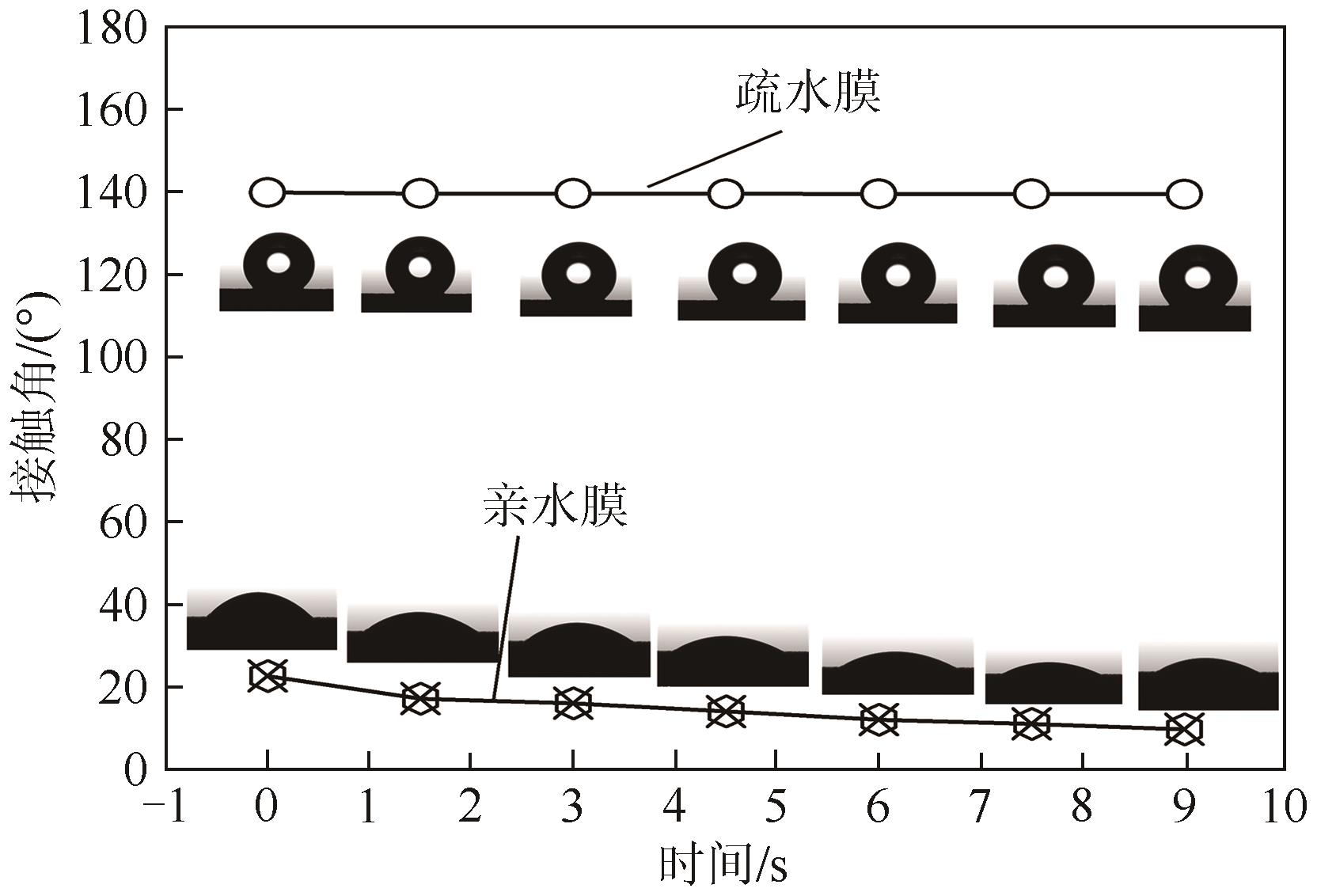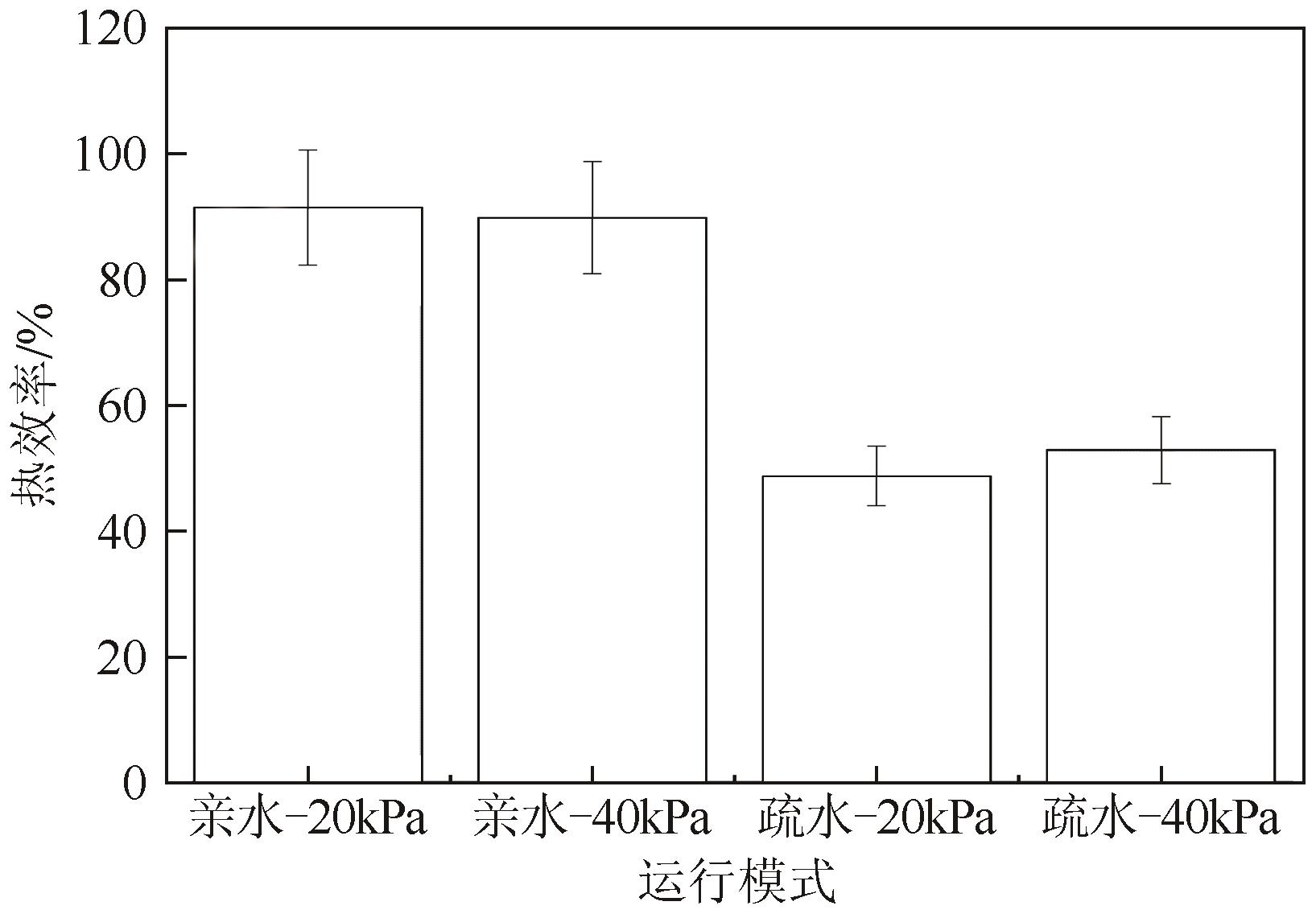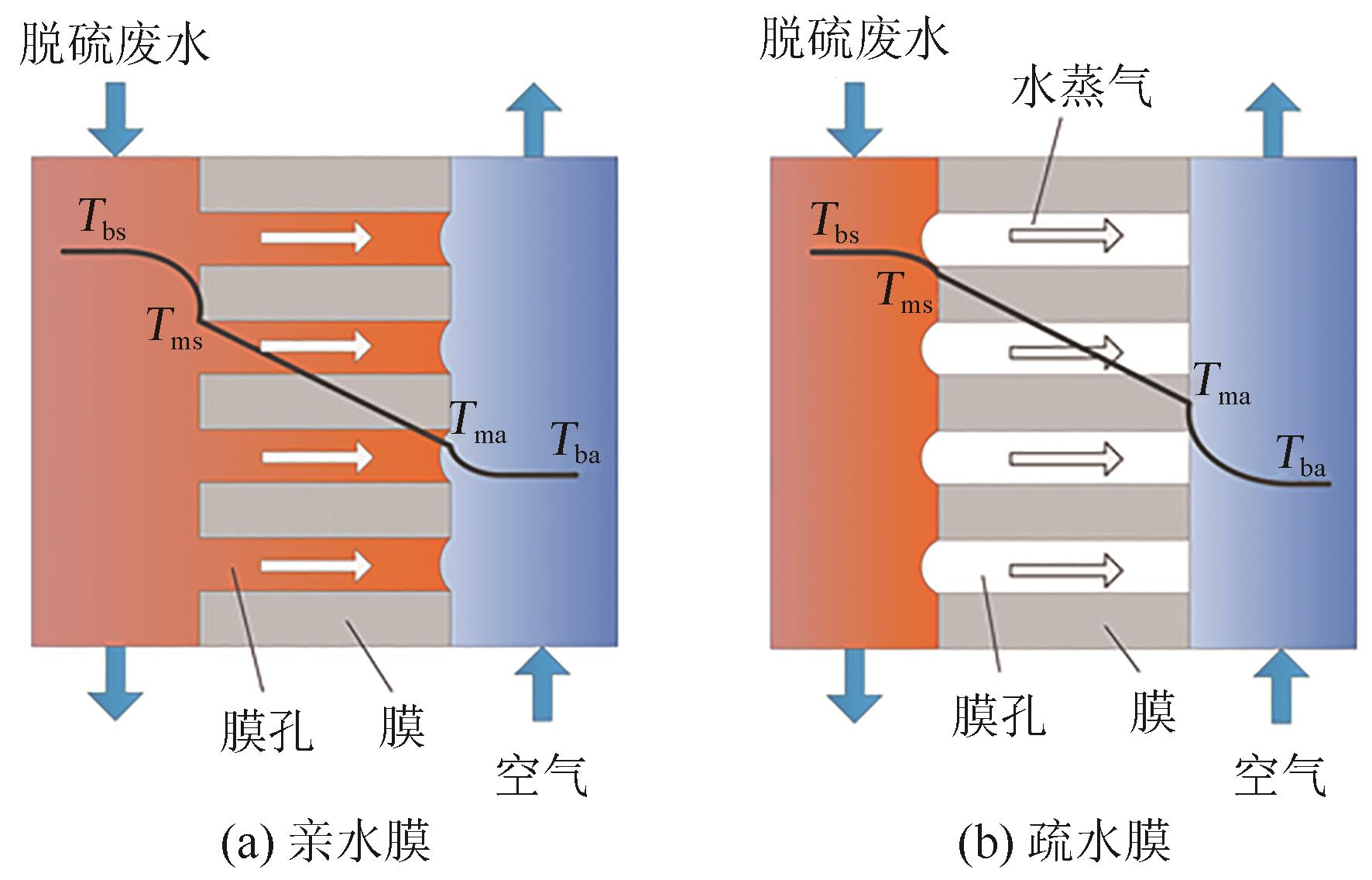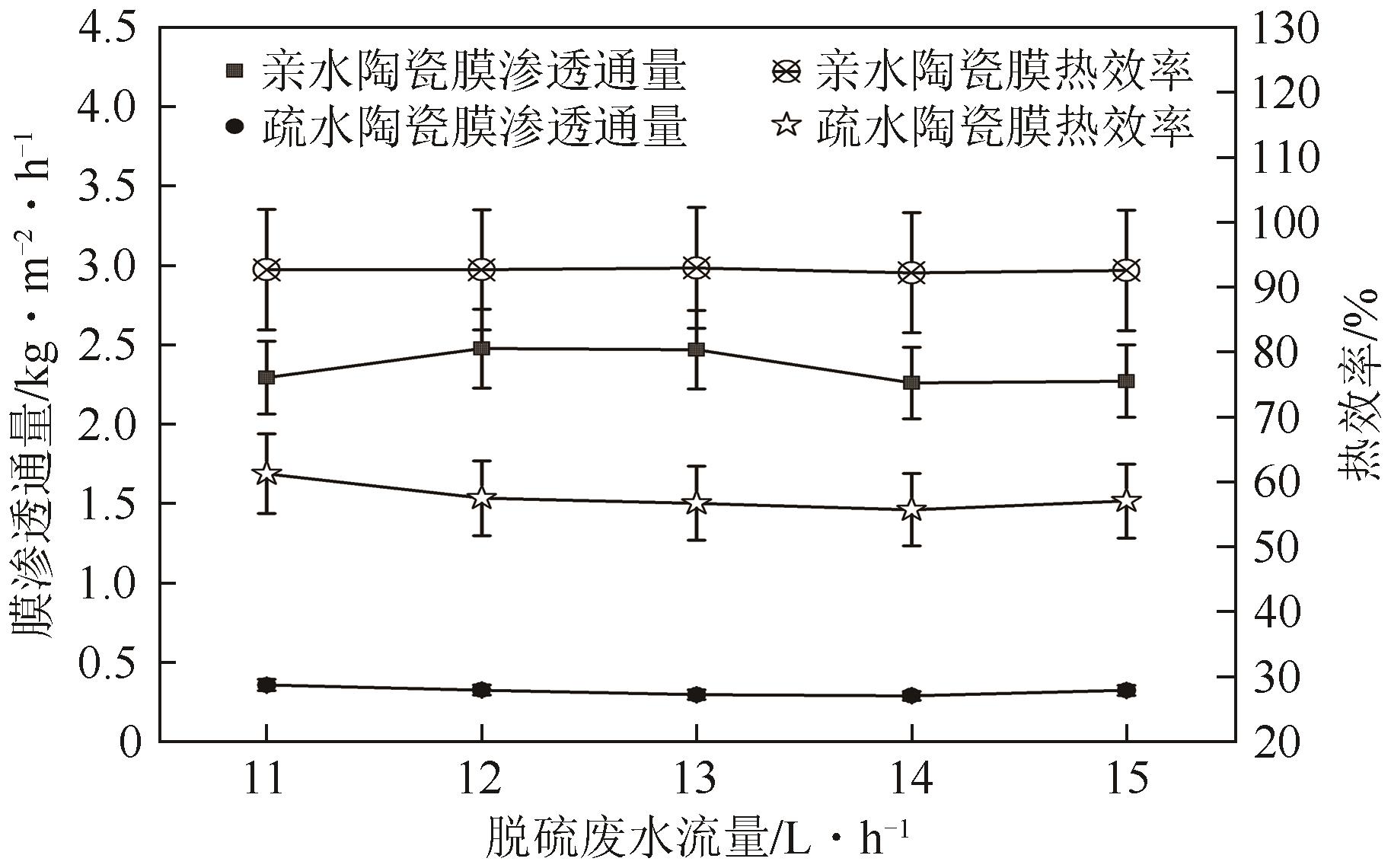化工进展 ›› 2023, Vol. 42 ›› Issue (12): 6649-6657.DOI: 10.16085/j.issn.1000-6613.2023-0164
• 资源与环境化工 • 上一篇
基于多孔陶瓷膜的脱硫废水负压式膜蒸馏实验
- 东莞理工学院广东省分布式能源系统重点实验室,广东 东莞 523808
-
收稿日期:2023-02-08修回日期:2023-05-06出版日期:2023-12-25发布日期:2024-01-08 -
通讯作者:肖烈晖 -
作者简介:陈君丹(1997—),女,硕士研究生,研究方向为膜蒸馏。E-mail:1486805222@qq.com。 -
基金资助:国家自然科学基金(52006038);广东省基础与应用基础研究基金(2019A1515110806);广东省分布式能源系统重点实验室项目(2020B1212060075)
Experimental study on membrane distillation of desulfurization wastewater with negative pressure using porous ceramic membrane
CHEN Jundan( ), YANG Minlin, HUANG Simin, XIAO Liehui(
), YANG Minlin, HUANG Simin, XIAO Liehui( )
)
- Guangdong Provincial Key Laboratory of Distributed Energy Systems, Dongguan University of Technology, Dongguan 523808, Guangdong, China
-
Received:2023-02-08Revised:2023-05-06Online:2023-12-25Published:2024-01-08 -
Contact:XIAO Liehui
摘要:
目前采用多孔陶瓷膜进行膜蒸馏的技术已有不少研究,但由于膜本身的亲水特性,需要在使用前进行疏水改性,这增加了工序和成本,且疏水性随着使用过程逐渐减弱。因此,提出一种基于多孔陶瓷膜的脱硫废水负压式膜蒸馏方法,直接采用亲水性多孔陶瓷膜,通过泵的抽吸作用使膜内溶液形成负压,以防溶液渗出膜外。为探究负压式膜蒸馏的传热传质机理,通过实验对比了亲、疏水多孔陶瓷膜在不同工况下的传递特性。实验结果表明:当膜内负压值小于膜孔内溶液毛细力时,亲、疏水多孔陶瓷膜的膜孔内分别为溶液输运和水蒸气输运;当空气流量为22L/min、废水温度和流量分别为50℃和11L/h时,亲水膜的渗透通量在1.9~3.9kg/(m2·h)之间,而疏水膜的渗透通量仅为0.13~0.25kg/(m2·h);亲、疏水多孔陶瓷膜的热效率分别在92%和55%左右,说明亲水性多孔陶瓷膜有着更高的热效率,陶瓷膜的较高热导率有利于提升亲水膜的膜蒸馏性能;脱硫废水流量对热质传递性能影响不大,随着空气流量或者废水温度的增加,膜渗透通量随之增加。
中图分类号:
引用本文
陈君丹, 杨敏林, 黄斯珉, 肖烈晖. 基于多孔陶瓷膜的脱硫废水负压式膜蒸馏实验[J]. 化工进展, 2023, 42(12): 6649-6657.
CHEN Jundan, YANG Minlin, HUANG Simin, XIAO Liehui. Experimental study on membrane distillation of desulfurization wastewater with negative pressure using porous ceramic membrane[J]. Chemical Industry and Engineering Progress, 2023, 42(12): 6649-6657.
| 陶瓷膜性能 | 参数 |
|---|---|
| 材料 | α-Al2O3 |
| 孔隙率 | 30% |
| 外径(ro)/mm | 12 |
| 内径(ri)/mm | 8 |
| 膜厚(δ)/mm | 2 |
| 平均孔径(dp)/μm | 6 |
| 有效长度(L)/m | 0.25 |
| 膜有效面积(A)/m2 | 0.00942 |
表1 多孔陶瓷膜参数
| 陶瓷膜性能 | 参数 |
|---|---|
| 材料 | α-Al2O3 |
| 孔隙率 | 30% |
| 外径(ro)/mm | 12 |
| 内径(ri)/mm | 8 |
| 膜厚(δ)/mm | 2 |
| 平均孔径(dp)/μm | 6 |
| 有效长度(L)/m | 0.25 |
| 膜有效面积(A)/m2 | 0.00942 |
| NaCl/g·L-1 | Na2SO4/g·L-1 | CaCl2/g·L-1 | MgCl2/g·L-1 |
|---|---|---|---|
| 11.199 | 0.038 | 0.005 | 0.048 |
表2 实验脱硫废水组成成分
| NaCl/g·L-1 | Na2SO4/g·L-1 | CaCl2/g·L-1 | MgCl2/g·L-1 |
|---|---|---|---|
| 11.199 | 0.038 | 0.005 | 0.048 |
| 设备名称 | 型号 | 测量范围 | 精度 |
|---|---|---|---|
| 椭圆齿轮流量计 | CX-M9-SS | 90~900mL/min | ±0.5% |
| 气体质量流量计 | GMFM-CXB-4 | 0~40L/min | ±1% |
| 热电偶 | T-type | -200~350℃ | ±0.1% |
| 压力计 | YE-75 | -100~0kPa | ±1% |
| 湿度温度计 | CENTER-314 | 0~100%RH | ±2.5% |
| 便携式电导率仪 | DDBJ-351L | 0.000~3000mS/cm | ±0.8% |
表3 实验测量仪器参数
| 设备名称 | 型号 | 测量范围 | 精度 |
|---|---|---|---|
| 椭圆齿轮流量计 | CX-M9-SS | 90~900mL/min | ±0.5% |
| 气体质量流量计 | GMFM-CXB-4 | 0~40L/min | ±1% |
| 热电偶 | T-type | -200~350℃ | ±0.1% |
| 压力计 | YE-75 | -100~0kPa | ±1% |
| 湿度温度计 | CENTER-314 | 0~100%RH | ±2.5% |
| 便携式电导率仪 | DDBJ-351L | 0.000~3000mS/cm | ±0.8% |
| 参数 | 数值 |
|---|---|
| 空气流量 | 12~22L/min |
| 废水流量 | 11~15L/h |
| 废水温度 | 50~70℃ |
| 废水压力 | -20kPa、-40kPa |
表4 实验运行参数
| 参数 | 数值 |
|---|---|
| 空气流量 | 12~22L/min |
| 废水流量 | 11~15L/h |
| 废水温度 | 50~70℃ |
| 废水压力 | -20kPa、-40kPa |
| 1 | 樊梅. 脱硫废水浓缩减量工艺研究[J]. 化工设计通讯, 2021, 47(12): 172-173. |
| FAN Mei. Discussion on concentration and reduction process of desulfurization wastewater[J]. Chemical Engineering Design Communications, 2021, 47(12): 172-173. | |
| 2 | 叶紫青, 郭士义, 姜正雄, 等. 燃煤电厂脱硫废水零排放工艺系统性能研究[J]. 水处理技术, 2022, 48(5): 128-131. |
| YE Ziqing, GUO Shiyi, JIANG Zhengxiong, et al. Study on the zero-discharge process system performance of desulfurization wastewater from coal-fired power plant[J]. Technology of Water Treatment, 2022, 48(5): 128-131. | |
| 3 | 付瑞超, 罗春欢, 苏庆泉. 钙基半干法燃煤烟气脱硫技术的影响因素[J]. 环境工程学报, 2022, 16(4): 1248-1255. |
| FU Ruichao, LUO Chunhuan, SU Qingquan. Influencing factors of coal-fired flue gas desulfurization by calcium-based semi-dry method[J]. Chinese Journal of Environmental Engineering, 2022, 16(4): 1248-1255. | |
| 4 | 逯亚鹏, 杨青青. 燃煤电厂脱硫废水处理方法研究进展[J]. 山东化工, 2022, 51(2): 50-52. |
| LU Yapeng, YANG Qingqing. Research progress of desulphurization wastewater treatment from coal-fired power plants[J]. Shandong Chemical Industry, 2022, 51(2): 50-52. | |
| 5 | 徐浩然, 封立林, 李强, 等. 燃煤电厂脱硫废水选择性电渗析浓缩处理中试研究[J]. 现代化工, 2022, 42(7): 236-240. |
| XU Haoran, FENG Lilin, LI Qiang, et al. Pilot study on selective electrodialysis concentrating treatment of desulfurization wastewater from coal-fired power plant[J]. Modern Chemical Industry, 2022, 42(7): 236-240. | |
| 6 | HAN Xiaoqu, ZHANG Dan, YAN Junjie, et al. Process development of flue gas desulphurization wastewater treatment in coal-fired power plants towards zero liquid discharge: Energetic, economic and environmental analyses[J]. Journal of Cleaner Production, 2020, 261: 121144. |
| 7 | 王智麟, 张胜寒, 祁伟健. 燃煤电厂脱硫废水中氯离子脱除技术研究进展[J]. 现代化工, 2021, 41(11): 67-71, 76. |
| WANG Zhilin, ZHANG Shenghan, QI Weijian. Research progress on technologies for removing chloride ion in desulfurization wastewater from coal-fired power plants[J]. Modern Chemical Industry, 2021, 41(11): 67-71, 76. | |
| 8 | 夏辉, 孙斌, 刘平, 等. 燃煤电厂脱硫废水膜分离处理技术进展及展望[J]. 山东化工, 2022, 51(2): 45-49. |
| XIA Hui, SUN Bin, LIU Ping, et al. Progress and prospectives of membrane separation technology for desulfurization wastewater in thermal power plants[J]. Shandong Chemical Industry, 2022, 51(2): 45-49. | |
| 9 | 丛玮, 曲云翔. 一种脱硫废水预处理软化工艺的应用[J]. 神华科技, 2019, 17(6): 92-95. |
| CONG Wei, QU Yunxiang. Application of a softening process for pretreatment of desulfurization wastewater[J]. Shenhua Science and Technology, 2019, 17(6): 92-95. | |
| 10 | 赵宁, 冯永新, 刘世念, 等. 燃煤电厂脱硫废水零排放工艺的应用进展[J]. 科技创新与应用, 2021, 11(34): 52-57. |
| ZHAO Ning, FENG Yongxin, LIU Shinian, et al. Application progress of zero discharge process of desulfurization wastewater in coal-fired power plants[J]. Technology Innovation and Application, 2021, 11(34): 52-57. | |
| 11 | 韩倩倩, 游晓宏, 朱一鸣, 等. 膜浓缩+蒸发塘处理工艺在燃气电厂废水零排放中的应用[J]. 现代化工, 2022, 42(8): 215-219. |
| HAN Qianqian, YOU Xiaohong, ZHU Yiming, et al. Application of membrane concentration+evaporation pond process in zero discharge treatment of wastewater from gas-fired power plant[J]. Modern Chemical Industry, 2022, 42(8): 215-219. | |
| 12 | AHMED F E, LALIA B S, HASHAIKEH R, et al. Alternative heating techniques in membrane distillation: A review[J]. Desalination, 2020, 496: 114713. |
| 13 | JULIAN Helen, NURGIRISIA Novesa, QIU Guanglei, et al. Membrane distillation for wastewater treatment: Current trends, challenges and prospects of dense membrane distillation[J]. Journal of Water Process Engineering, 2022, 46: 102615. |
| 14 | CAI Jingcheng, GUO Fei. Mass transfer during membrane distillation treatment of wastewater from hot-dip galvanization[J]. Separation and Purification Technology, 2020, 235: 116164. |
| 15 | SI Zetian, HAN Dong, XIANG Jiawei. Experimental investigation on the mechanical vapor recompression[J]. Separation and Purification Technology, 2021, 275: 119178. |
| 16 | JIA Chenhui, LIU Pei, LI Zheng. Performance analysis of ceramic membrane tube modules for water and heat recovery in coal-fired power plants[J]. Journal of Cleaner Production, 2021, 306: 127237. |
| 17 | LI Chen, SUN Wenjun, LU Zedong, et al. Ceramic nanocomposite membranes and membrane fouling: A review[J]. Water Research, 2020, 175: 115674. |
| 18 | ABADI S R H, SEBZARI M R, HEMATI M, et al. Ceramic membrane performance in microfiltration of oily wastewater[J]. Desalination, 2011, 265(1/2/3): 222-228. |
| 19 | KO C C, ALI A, DRIOLI E, et al. Performance of ceramic membrane in vacuum membrane distillation and in vacuum membrane crystallization[J]. Desalination, 2018, 440: 48-58. |
| 20 | HUBADILLAH S K, TAI Z S, OTHMAN M H D, et al. Hydrophobic ceramic membrane for membrane distillation: A mini review on preparation, characterization, and applications[J]. Separation and Purification Technology, 2019, 217: 71-84. |
| 21 | LU Jun, YU Yun, ZHOU Jianer, et al. FAS grafted superhydrophobic ceramic membrane[J]. Applied Surface Science, 2009, 255(22): 9092-9099. |
| 22 | DONG Shuangshuang, YUN Yanbin, WANG Manxiang, et al. Superhydrophobic alumina hollow ceramic membrane modified by TiO2 nanorod array for vacuum membrane distillation[J]. Journal of the Taiwan Institute of Chemical Engineers, 2020, 117: 56-62. |
| 23 | YANG Yanhui, LIU Qianqian, WANG Haizhi, et al. Superhydrophobic modification of ceramic membranes for vacuum membrane distillation[J]. Chinese Journal of Chemical Engineering, 2017, 25(10): 1395-1401. |
| 24 | CONG Shuo, LIU Xiaohua, GUO Fei. Membrane distillation using surface modified multi-layer porous ceramics[J]. International Journal of Heat and Mass Transfer, 2019, 129: 764-772. |
| 25 | HUANG C Y, KO C C, CHEN L H, et al. A simple coating method to prepare superhydrophobic layers on ceramic alumina for vacuum membrane distillation[J]. Separation and Purification Technology, 2018, 198: 79-86. |
| 26 | 郭凯伦, 王成龙, 张大林, 等. 纳米多孔超亲水不锈钢席型网毛细力特性研究[J]. 核动力工程, 2021, 42(S1): 58-62. |
| GUO Kailun, WANG Chenglong, ZHANG Dalin, et al. Capillary characteristic investigation of porous nano-structured stainless steel wire mesh[J]. Nuclear Power Engineering, 2021, 42(S1): 58-62. | |
| 27 | WANG Fang, WANG Xiufang, XIE Anjian, et al. A simple method for preparation of transparent hydrophobic silica-based coatings on different substrates[J]. Applied Physics A, 2012, 106(1): 229-235. |
| 28 | 张大帅, 李晨, 张小朋, 等. 料液强化流动对气扫式膜蒸馏影响的实验研究[J]. 膜科学与技术, 2018, 38(3): 91-96, 109. |
| ZHANG Dashuai, LI Chen, ZHANG Xiaopeng, et al. Research on sweeping gas membrane distillation of enhanced liquid flow[J]. Membrane Science and Technology, 2018, 38(3): 91-96, 109. | |
| 29 | 熊玉琴, 张梅梅, 王仕超, 等. 脉冲流强化膜蒸馏高浓度盐水的研究[J]. 膜科学与技术, 2016, 36(3): 98-102. |
| XIONG Yuqin, ZHANG Meimei, WANG Shichao, et al. Research on membrane distillation of high-concentration saline solution with pulsatile flow[J]. Membrane Science and Technology, 2016, 36(3): 98-102. | |
| 30 | XIAO Liehui, YANG Minlin, YUAN Wuzhi, et al. Performance characteristics of a novel internally-cooled plate membrane liquid desiccant air dehumidification system[J]. Applied Thermal Engineering, 2020, 172: 115193. |
| 31 | LEE Taemin, MIN Choongsik, NAIDU Gayathri, et al. Optimizing the performance of sweeping gas membrane distillation for treating naturally heated saline groundwater[J]. Desalination, 2022, 532: 115736. |
| [1] | 徐杰, 夏隆博, 罗平, 邹栋, 仲兆祥. 面向膜蒸馏过程的全疏膜制备及其应用进展[J]. 化工进展, 2023, 42(8): 3943-3955. |
| [2] | 李雪佳, 李鹏, 李志霞, 晋墩尚, 郭强, 宋旭锋, 宋芃, 彭跃莲. 亲水和疏水改性膜的抗结垢和润湿能力的对比[J]. 化工进展, 2023, 42(8): 4458-4464. |
| [3] | 张东, 刘鹏飞, 刘春阳, 侯刚, 惠博, 安周建. 太阳能PV/T光储直驱热电联产系统性能[J]. 化工进展, 2023, 42(6): 2895-2903. |
| [4] | 王震, 闫霆, 霍英杰. 氯化锰/氨热化学吸附储热的特性[J]. 化工进展, 2022, 41(8): 4425-4431. |
| [5] | 杨希刚, 陈国庆, 黄林滨, 古世军, 李昌松, 张勇, 金保昇. 尿素法SNCR对大型电站煤粉锅炉运行影响的工业试验[J]. 化工进展, 2022, 41(7): 3573-3581. |
| [6] | 莫乾赐, 叶海波, 林行素, 李国华, 陈伟崇, 卢苇. 基于测试数据的蔗渣锅炉能量分析及能效提升措施[J]. 化工进展, 2022, 41(6): 3350-3359. |
| [7] | 石一慈, 潘艳秋, 王成宇, 范嘉禾, 俞路. 焦耳效应强化气隙式膜蒸馏脱盐过程的实验研究[J]. 化工进展, 2022, 41(5): 2285-2291. |
| [8] | 李洞, 石雨, 张亮, 李俊, 付乾, 朱恂, 廖强. 采用有机溶剂的热再生电池性能[J]. 化工进展, 2022, 41(12): 6302-6309. |
| [9] | 马顺选, 宋小三, 王三反, 张轩. 渗透汽化膜的制备及其应用进展[J]. 化工进展, 2021, 40(S2): 256-264. |
| [10] | 宋永, 李恋, 陈志. 基于气隙式膜蒸馏的溴化锂吸收式制冷系统COP的优化[J]. 化工进展, 2021, 40(S1): 150-155. |
| [11] | 谢松辰, 文剑平, 庞志广, 侯春光, 李志霞, 晋墩尚, 彭跃莲. 膜蒸馏脱盐中膜污染与膜润湿的研究进展[J]. 化工进展, 2021, 40(7): 3942-3956. |
| [12] | 刘立新, 赵晓非, 赖家凤, 邱观平, 李乾峰, 陈俊宇. 膜蒸馏脱盐过程膜润湿的研究进展[J]. 化工进展, 2021, 40(6): 3072-3082. |
| [13] | 任静, 刘状, 郭淑娟, 李剑锋, 程芳琴. 亲水/疏水复合膜强化膜蒸馏深度处理工业废水的研究进展[J]. 化工进展, 2021, 40(11): 6347-6357. |
| [14] | 朱腾义, 曹再植. 正渗透-膜蒸馏耦合工艺在高难度废水处理中的应用研究进展[J]. 化工进展, 2021, 40(11): 5894-5906. |
| [15] | 高凯华, 茆羊羊, 刘公平, 金万勤. 疏水石墨烯膜的制备及其用于膜蒸馏脱盐的研究进展[J]. 化工进展, 2020, 39(6): 2135-2144. |
| 阅读次数 | ||||||
|
全文 |
|
|||||
|
摘要 |
|
|||||









